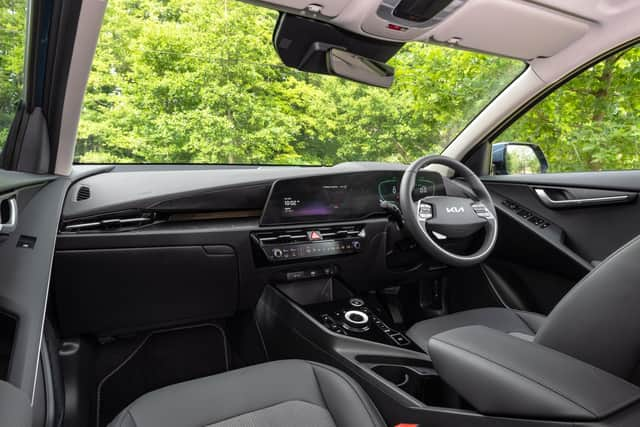MOTORS REVIEW: Kia Niro


Walking into a modern showroom can be (almost) as daunting as your first attempt at ordering a Subway sandwich.
Alone in offering every possible AFV drivetrain option barring hydrogen fuel cell is the Kia Niro.
Advertisement
Hide AdAdvertisement
Hide AdIf a practical large family hatchback-cum-crossover is what you are after, then you can take your pick from hybrid, plug-in hybrid (PHEV) or fully electric (EV).
As the Korean carmaker homes in on a record 100,000 registrations in the UK – despite production issues crippling the growth of most rivals – the Niro encapsulates its target of offering customers a breadth of choice to ensure their needs are met... Supposedly leaving them with little reason to walk away.
Niro prices start at £28,245 for the hybrid without a plug, with its 141PS 1.6-litre petrol/electric drivetrain which serves-up CO2 emissions from 100g/km, and 64.2mpg fuel economy.
We got behind the wheel of the more zero-emission capable plug-in versions, however.
Advertisement
Hide AdAdvertisement
Hide AdIn PHEV guise (from £34,045) the Niro couples a larger 62kW electric motor to that 1.6-litre engine to develop 182PS and 265Nm of torque and – with the help of an all-electric range of up to 40 miles – a rather non-indicative 353mpg fuel economy figure alongside CO2 emissions as low as 18g/km.
The 64.8kWh lithium-ion polymer battery of the Niro EV (from £36,745) feeds energy into a 204PS, 255Nm of torque motor and is capable of up to 285 miles on a single charge.
There are 2, 3 and 4 trim levels available for each car, with the step up between each being around £2,500. Driven here were the PHEV 3 (£36,775) and EV 2.
The pricing positions the Niro just behind the Sportage which could, along with its SUV rivals, compete for consideration for Niro PHEV customers alongside the likes of the Peugeot 3008 or Nissan Qashqai.
Advertisement
Hide AdAdvertisement
Hide AdIn EV form the Niro is a more spacious option than Volkswagen’s more expensive ID.3, with its 475-litre boot adding significant levels of practicality that can only be matched by the MG 5 at this price.


The latest Niro is slightly larger than its predecessor at 4,420mm long (up 65mm), 1,825mm wide (up 10mm), a 1,545mm tall (up 10mm), and a wheelbase of 2,720mm (up 20mm).
The cabin apes the Sportage and EV6 with its rotary gear selector and – in the 3 trim, at least – dual 10.25-inch displays integrated into a single panel incorporating the infotainment and instrument cluster displays, along with a head-up display projected onto the windscreen.
The ‘2’ trim EV featured a smaller eight-inch touchscreen infotainment screen and dispensed with that head-up display, but retained the same colour instrument binnacle.
Advertisement
Hide AdAdvertisement
Hide AdThoughtful design innovations carried over from the Sportage include front headrests sculpted to double-up as clothing or bag hooks, while there are fast-charging USB ports on the inside of each front seat.
I also like the way a black panel on the dashboard fulfils the dual role of serving-up a climate control instrument panel and sat-nav/infotainment shortcuts, switching its function at the push of a button.
Overall, the Niro’s interior is defined by its tall, spacious feel.
Some of the plastics look unusual, the hard plastic of the door inserts bearing a patina effect.
Advertisement
Hide AdAdvertisement
Hide AdUnderstanding that the Niro forms a showcase for recycled materials helps understand their eco-friendly provenance.
The headlining is made from recycled wallpaper, the seats from Bio PU with Tencel from eucalyptus leaves, and BTX-free paint is used on the door panels to minimize the impact on the environment and reduce waste.
It is also nice to see functional engineering in the Niro’s body panels.
In contrast to the kind of naff pretend air vents on the latest V8-engined Ford Mustang, for example, the C-pillars of the Niro, which can be painted a contrasting colour to give a dubious Audi R8 look, contain air channels to improve the car’s aerodynamics.
They seem to do the trick.


Advertisement
Hide AdAdvertisement
Hide AdWhile the EV appeared good for its claimed range, almost more impressive was the PHEV’s 60-plus mpg fuel economy with no charge in its battery.
I charged whenever I could to maximise the cost-saving of a home charge, but it was good to know that longer journeys would still return good economy.
Performance-wise the Niro is a reliable steer, if not designed for dynamic thrills, but balances reasonable chassis control with an impressively comfortable ride.
The PHEV should reach 62mph in 9.8 seconds and a 100mph while the EV feels immediately more sprightly. It will reach 62mph in 7.8 seconds and should top out at 103mph.
Advertisement
Hide AdAdvertisement
Hide AdTailoring of the regenerative braking effect of the EV drivetrain is also possible via the steering wheel mounted paddles.
Regular readers will know I like the added control of this ‘in-gear’ effect, which also serves to minimise the necessity to brake.
Overall, the Niro is a very practical, functional and uncomplicated car, despite its vast range offering and a raft of technology which I could not do full justice to here.
Underpinned by a seven-year warranty it is welcome proof that the headache of choosing the right electrified car should result in stress-free family motoring.